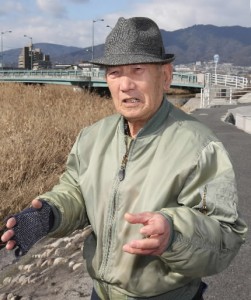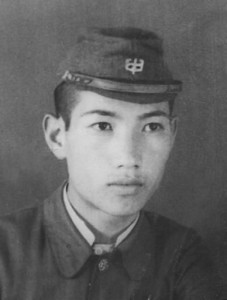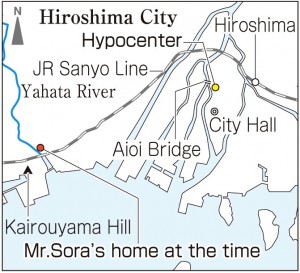Kazuo Sora, 85, Saeki Ward, Hiroshima
Mar. 5, 2015
At scenes of hell, his heart grew numb and felt nothing
Kazuo Sora lives near Kairouyama Hill, an area known for its beautiful cherry trees in Saeki Ward. In the spring, people flock to Karirouyama Hill to enjoy the cherry blossoms. Mr. Sora, however, is reluctant to join them because the mountain a grim reminder of the atomic bombing. In the past, he would not even share his story.
He was 15 years old in 1945, a student at Sanyo Junior High School. On August 6, instead of joining other mobilized students who were helping to dismantle buildings in the city to create fire lanes, he stayed at home near the Yahata River in Itsukaichi, now part of present-day Saeki Ward, to help with the family business, a rice shop. It was located about 8.2 kilometers from the hypocenter.
At 8:15 a.m., the house was hit by a white flash. The milling machine stopped working, and the transformer on a utility pole outside burst into flame. Then there was a great boom. Part of the ceiling was pushed upward by the strong winds from the blast.
When Mr. Sora looked in the direction of the city center, he saw a gray mushroom cloud boiling up to the sky. Black rain fell and the surface of the nearby river was covered with the bodies of small fish.
Following the side of the river, the survivors fled to his part of town. One woman’s clothes had melted and were stuck to her body like a pattern on her skin. A child’s hair was frizzy, the face swollen. There were many more pitiful victims in the line of people staggering past. Mr. Sora and his father turned to each other. “This wasn’t an ordinary bomb, was it?” they said.
Many of the people pleaded for water. Although it was hard to refuse them, Mr. Sora was told that those who suffered burns should not be given any. One after another, the victims collapsed to the ground and did not rise again.
The people in his area became busy cremating the dead. Since the local crematory could not handle so many bodies, holes were dug at Kairouyama Hill and the bodies were soaked with oil and burned. “I guess this lasted about a week,” Mr. Sora said. He was so fearful that he didn’t approach the site. But he still remembers the smoke and the smell of that time, wafting from the hill.
Around August 9, Mr. Sora went to the city center. He wanted to visit his sister in the city of Kure (not far from Hiroshima) to check on her since he could not contact her after the bombing, and find out what happened to relatives living in downtown Hiroshima, in Tokaichi (part of today’s Naka Ward.) One relative, a boy who was a few years younger, had fled from Tokaichi and, a day or two after the bombing, reached Mr. Sora’s house in Itsukaichi despite suffering severe burns.
He left home in a wagon. The heart of Hiroshima was only charred rubble. He went on by following the tracks of a streetcar line. One burnt streetcar stood alone on the tracks. The passengers inside had been charred black, and the mass still made a sizzling sound. “It was truly a scene from hell,” he said. “But I didn’t feel anything because my heart was numb.”
Fortunately, the boy recovered, thanks to the care given by Mr. Sora’s mother, who applied egg yolk to the boy’s wounds. But their relatives’ home in Tokaichi was wiped away, without a trace, and the boy’s parents vanished as well.
His horse would not go forward and cross the Aioi Bridge, located by today’s A-bomb Dome. “Horses are clever,” Mr. Sora explained. “So I assume he was reacting to the smell of burnt flesh.” So he could only turn back and head home. It was a while before he learned that his sister was safe.
Mr. Sora can be considered an A-bomb survivor because he was near the hypocenter within several days of the atomic bombing. In spite of this, he has not applied for the official Atomic Bomb Survivor’s Certificate. “So many people suffered and died because of the atomic bombings, and the war,” he explained. “I can’t bear the thought of receiving the certificate instead of them, just because I survived.”
After the war, Mr. Sora worked in Tokyo for three years. After returning to Hiroshima, he established a fuel supply company and worked hard his whole life. “I saw something very tragic,” he said. “It feels cruel to talk about it to today’s young people.” This is one reason he has been reluctant to tell his story to others.
Nevertheless, as times passes and the number of people who have direct experience of the atomic bombing dwindles, he has recently come to think, “If people ask me to tell my story, I should share as much as I know.” At the same time, he would prefer to avoid such painful memories. He feels torn between these two sides of his heart. (Eriko Shintani, Staff Writer)
Teenagers’ Impressions
Glad to hear his story in person
Mr. Sora said over and over that his experience was so sad that he couldn’t share it with young people. I think this is because his encounters with the people who were wounded badly in the atomic bombing were so powerful. It was certainly sad, but I’m glad I had the chance to listen to his story in person. When he said, “War should never be acceptable,” my desire to work for a peaceful world grew even stronger. (Miki Meguro, 12 years old)
Need to make efforts to prevent war
It was a shock for me when he said, “There were so many bodies that had to be cremated. I realized that this was the reality of war.” He also told us that war should never take place again because so many innocent people are killed or feel sorrow. I thought again about how we have to make efforts so that such a tragic event is never repeated. (Nana Kawaichi, 13 years old)
Respect for his courage
Over and over, he described the catastrophe of 70 years ago by saying, “It was so horrible. I can’t express it in words.” I respect him because he had the courage to tell us about such a sad experience that he really didn’t want to remember. He also emphasized the importance of “being assertive.” I’d like to be the kind of person who can insist that what’s wrong is wrong. (Moe Nakano, 16 years old)
(Originally published on February 23, 2015)









